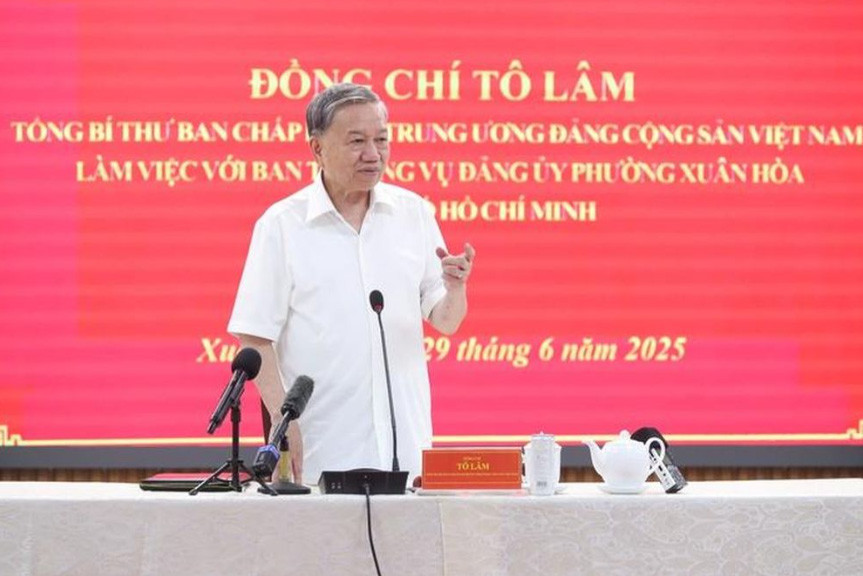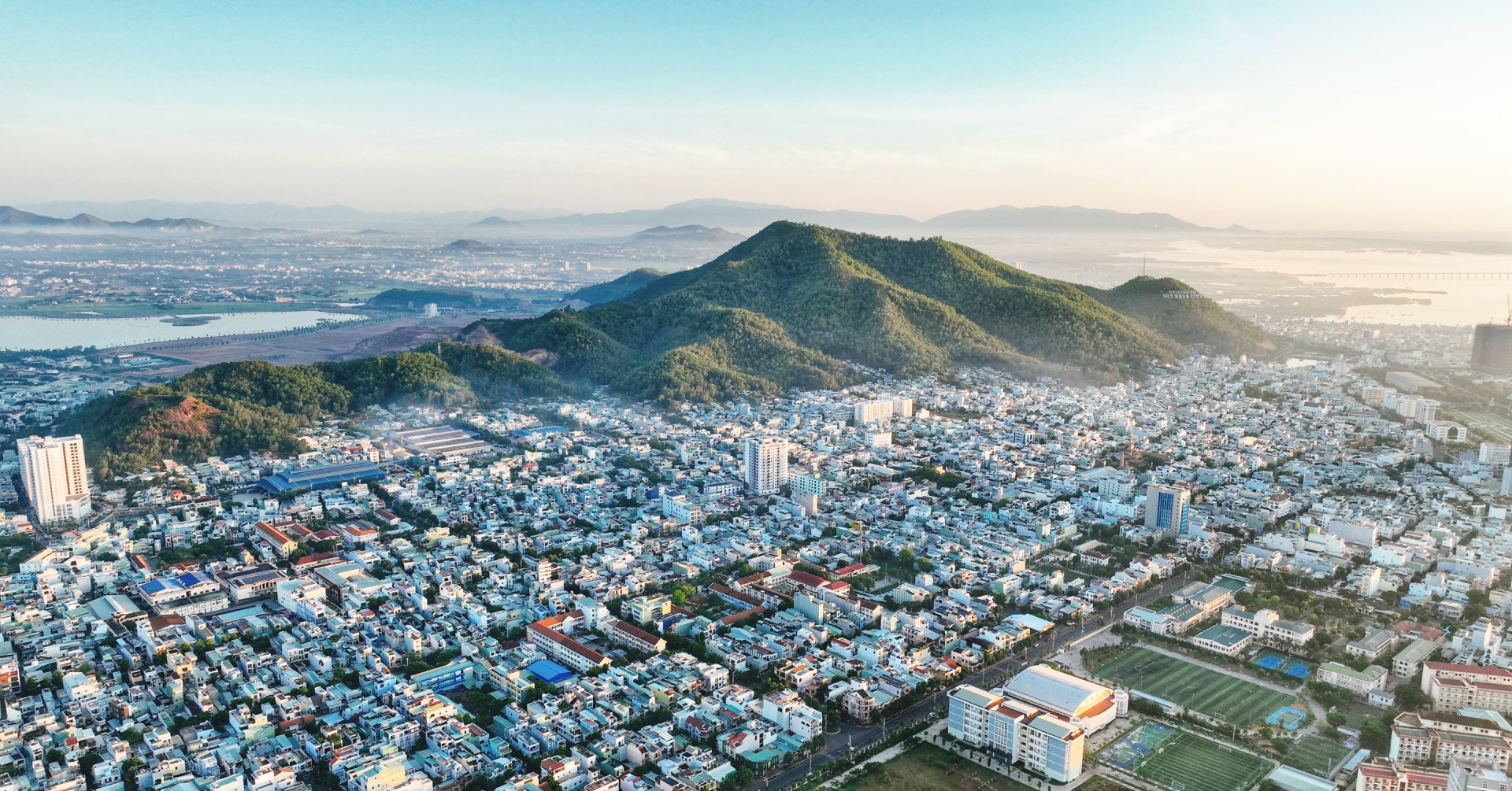This reform is more than just redrawing administrative borders or restructuring government agencies - it is a redefinition of the relationship between the State and the people, between central and local governance, and between the State and the market.
Redrawing the nation's boundaries

On June 29, a central working delegation led by General Secretary To Lam met with the Party Committee of Xuan Hoa Ward, Ho Chi Minh City.
The General Secretary emphasized that the new administrative unit at the ward level must adopt a new mindset. While previously focused on administration and control, local authorities must now shift toward creation and service. Any matter affecting people in the ward must be addressed without delay, and issues beyond local jurisdiction must be promptly reported to the city.
As of July 1, District 3 officially concluded its 50-year historical journey, giving rise to three new wards: Ban Co, Xuan Hoa, and Nhieu Loc.
Xuan Hoa Ward is a key political and security area, home to major central and city-level agencies, consulates of countries like China, Russia, and Japan, as well as religious institutions such as the Archdiocese of Saigon and Vinh Nghiem Pagoda.
The visit marked a critical moment as HCMC merged with Binh Duong and Ba Ria – Vung Tau, retaining the name Ho Chi Minh City. The new city spans over 6,772 square kilometers, has a population of over 14 million, and comprises 168 commune-level administrative units.
Nationally, Vietnam now has 34 provinces (down from 63), with commune-level units reduced from 10,035 to 3,321, and the district-level administration eliminated.
To enable this transformation, the National Assembly amended the Constitution, the Law on Local Government Organization, and the Law on Government Organization. The government issued 28 decentralization decrees, along with nearly 40 others.
As General Secretary To Lam stated, this is a true “redrawing of the nation.” The new three-tier government structure - central, provincial/city, and commune/ward - aligns Vietnam with a model adopted by roughly 80% of countries worldwide.
This is not just an administrative reorganization; it is a full institutional revolution that reflects the Party and State’s commitment to reform and strategic vision.
The restructuring aims to create broader economic zones, connecting regions and harnessing local strengths to propel Vietnam into a new era. Most newly merged provinces have populations of 2–3 million, large economies, and diverse terrains - mountains, plains, and coastlines - enabling them to evolve into strong, viable economic hubs.
Notably, the new Ho Chi Minh City - after merging with industrial center Binh Duong and industrial-tourism hub Ba Ria – Vung Tau - is poised to rival regional economic powerhouses.
Accompanying the restructuring are policies promoting infrastructure, science and technology, digital transformation, high-speed rail, nuclear energy, and financial centers.
Unity is key

Dr. Tran Khac Tam, President of the Soc Trang Business Association, warned that the challenge lies in harmonizing interests and avoiding unhealthy competition between newly merged regions. A merit-based system must be established, free of local favoritism.
General Secretary To Lam also highlighted this concern in his article “The Power of Unity in Streamlining Government.” Without unity, internal divisions may emerge - especially among officials whose roles are eliminated or reassigned.
Regional pride and attachment also pose challenges. Merging regions raises questions about new names, office locations, and personnel appointments, which can spark friction if not handled fairly.
Mergers between mountainous and lowland areas, or between wealthy and poorer provinces, require leaders with integrity and vision to ensure balanced resource allocation and equitable development.
An outdated administrative model
Since 1945, Vietnam has operated under a four-tier system - central, provincial, district, and commune - typical of former socialist countries. Local agencies answered to both vertical (sectoral) and horizontal (local) management.
Each level had full political and administrative structures, which ensured centralized control but also created a bloated, overlapping bureaucracy.
For example, an investment project might pass through departments, People’s Committees, and People’s Councils at multiple levels, then on to ministries and the government - resulting in delays and high administrative costs.
Few countries still follow this dual-subordination model. Vietnam is among the last.
A government that builds and serves
According to international studies cited by General Secretary To Lam, about 80% of countries now use a three-tier model. Vietnam is aligning with this, restructuring its government into central – provincial – commune levels.
He noted that the commune level is now the most crucial, as it is closest to the people. Weak local governance means national policy fails to reach citizens. But with real power and responsibility, the commune becomes the foundation of an effective system.
This marks a shift from command-and-control to autonomy and service - from oversight to support.
The reform eliminates the district level, transferring over 100 responsibilities to provinces and nearly 600 to communes. This increases local authority, trims staff, reduces budget waste, and boosts efficiency.
As Prime Minister Pham Minh Chinh stated, this is a “revolution” in administrative structure and management thinking. Governments should no longer wait for citizens to knock - they must proactively engage, listen, and resolve problems.
This shift from “administrative management” to “constructive governance and service” redefines the State not as a controller, but as a partner in community development.
The three-tier model is a comprehensive, transformative move. It does not simply reorganize space or bureaucracy - it reconfigures the relationship between State and people, central and local, State and market.
Its success requires innovation, social consensus, and decisive action. Only with a lean, effective government - one that is close to and serves its citizens - can Vietnam achieve faster, stronger, and more sustainable development.
Tu Giang – Lan Anh